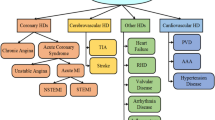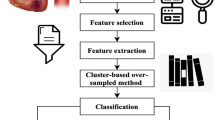Abstract
The leading global cause of death is cardiovascular disease (CVD), also referred to as heart disease. A recent World Heart Federation study shows that cardiovascular disease is responsible for one in every three deaths. Stress, alcohol, smoking, poor diet, lack of exercise, and other linked health issues including diabetes or high blood pressure can all contribute to cardiovascular disease. On the other hand, most cardiovascular disease. There is known to be a complete cure for linked disorders when detected early. Emerging novel data analysis strategies may allow for early detection of cardiovascular disease by examining a patient's medical file. Cardiovascular disease is currently predicted using clinical datasets and machine learning (ML) algorithms. However, because of the disparity in classes and high dimension, clinical datasets pose significant challenges. To address such issues, a dynamic model is proposed. In this paper, an effective decision support (or assistive) system is proposed by combining a deep learning classifier and an optimization technique to detect and classify cardiovascular diseases. It is expected that combining the two strategies will increase the effectiveness of current approaches for using clinical records to anticipate cardiovascular disease. According to clinical data and the severity level of the patient, a deep learning system can anticipate cardiovascular disease in its initial stages, lowering rates of death. The optimization method determines the best parameters for a sufficient quantity of synthesised samples to achieve the best prediction with an optimised classifier. In addition, various parameters such as accuracy, PSNR, sensitivity, specificity, and others were computed and compared with existing systems in this work.
Access this chapter
Tax calculation will be finalised at checkout
Purchases are for personal use only
Similar content being viewed by others
References
Abdellatif A, Abdellatef H, Kanesan J, Chow CO, Chuah JH, Gheni HM (2022) An effective heart disease detection and severity level classification model using machine learning and hyperparameter optimization methods. IEEE Access 10:80157–80173
Abubaker MB, Babayigit B (2022) Detection of cardiovascular diseases in ecg images using machine learning and deep learning methods. IEEE Trans 1–10
Magesh G, Swarnalatha P (2021) Optimal feature selection through a cluster-based DT learning (CDTL) in heart disease prediction. Evol Intel 14:583–593
Akhil jabbar M, Deekshatulu BL, Chandra P (2013) Classification of heart disease using K- Nearest Neighbour and genetic algorithm. Procedia Technol 10:85–94
Ali L, Niamat A, Khan JA, Golilarz NA, **ngzhong X, Noor A, Nour R, Bukhari SA (2019) An optimized stacked support vector machines based expert system for the effective prediction of heart failure. IEEE Access 7:54007–54014
Long NC, Meesad P, Unger H (2015) A highly accurate firefly-based algorithm for heart disease prediction. Expert Syst Appl
Sowmiya C, Sumitra P (2021) A hybrid approach for mortality prediction for heart patients using ACO-HKNN. J Ambient Intell Humaniz Comput 12(5):5405–5412
Ishaq, Sadiq S, Umer M, Ullah S, Mirjalili S, Rupapara V, Nappi M (2021) Improving the prediction of heart failure patients’ survival using SMOTE and effective data mining techniques. IEEE Access 9:39707–39716
Selvi RT, Muthulakshmi I (2021) An optimal artifificial neural network based big data application for heart disease diagnosis and classification model. J Ambient Intell Humaniz Comput 12(6):6129–6139
Asmare MH, Woldehanna F, Janssens L, Vanrumste B (2020) Rheumatic heart disease detection using deep learning from spectro-temporal representation of un-segmented heart sounds. IEEE Xplore
Waqar M, Dawood H, Dawood H, Majeed N, Banjar A, Alharbey R (2021) An effificient SMOTE-based deep learning model for heart attack prediction. Sci Program 2021:1–12
Balaha HM, Shaban AO, El-Gendy EM, Saafan MM (2022) A multi-variate heart disease optimization and recognition framework. Neural Comput Appl 15907–15944
Kishore A, Kumar A, Singh K, Punia M, Hambir Y (2018) Heart attack prediction using deep learning. Int Res J Eng Technol (IRJET) 5(4):4420–4423
Deepika P, Sasikala S (2021) Enhanced model for prediction and classification of cardiovascular disease using decision tree with particle swarm optimization. IEEE Xplore 1068–1072
Ahmad GN, Fatima H, Saidi AS, Imdadullah (2022) Efficient medical diagnosis of human heart diseases using machine learning techniques with and without GridSearchCv. IEEE Access 10:80151–80173
Saboor A, Usman M, Ali S, Samad A, Abrar MF, Ullah N (2022) A method for improving prediction of human heart diseases using machine learning algorithms, vol 2
Chang V, Bhavani VR, Xu AQ, Hossain MA (2022) An artificial intelligence model for heart disease detection using machine learning algorithms 2
Sujatha P, Mahalakshmi K (2020) Performance evaluation of supervised machine learning algorithms in prediction of heart disease. IEEE Int Conf Innov Technol (Inocon)
Pan Y, Fu M, Cheng B, Tao X, Guo J (2020) Enhanced deep learning assisted convolutional neural network or heart disease prediction on the internet of medical things platform. IEEE Access 8:189503–189512
Li JP, Haq AU, Din SU, Khan J, Khan A, Saboor A (2020) Heart disease identification method using machine learning classification in e-healthcare 8:107562–107582
Gaddam DKR, Ansari MD, Vuppala S, Gunjan VK, Sati MM (2022) A performance comparison of optimization algorithms on a generated dataset. In: ICDSMLA 2020: proceedings of the 2nd international conference on data science, machine learning and applications. Springer Singapore, pp 1407–1415
Talukdar J, Singh TP, Barman B (2023) Knowledge representation and reasoning. In: Artificial intelligence in healthcare industry. Springer Nature Singapore, Singapore, pp 17–40
Gunjan VK, Kumar S, Ansari MD, Vijayalata Y (2022) Prediction of agriculture yields using machine learning algorithms. In: Proceedings of the 2nd international conference on recent trends in machine learning, IoT, smart cities and applications: ICMISC 2021. Springer Singapore, pp. 17–26
Choudhury A, Singh TP, Biswas A, Anand M (eds) (2022) Evolution of digitized societies through advanced technologies. Springer
Venkatesh C, Bojja P (2020) Lung cancer detection using bio-inspired algorithm in CT scans and secure data transmission through IoT cloud 11(11):373–379
Siddiquee KNEA, Islam MS, Singh N, Gunjan VK, Yong WH, Huda MN, Naik DB (2022) Development of algorithms for an iot-based smart agriculture monitoring system. Wirel Commun Mob Comput 2022:1–16
Fantin Irudaya Raj E, Appadurai M (2022) Internet of things-based smart transportation system for smart cities. In: Intelligent systems for social good: theory and practice. Springer Nature Singapore, Singapore, pp 39–50
Rashid E, Ansari MD, Gunjan VK, Ahmed M (2020) Improvement in extended object tracking with the vision-based algorithm. In: Modern approaches in machine learning and cognitive science: a walkthrough: latest trends in AI, pp 237–245
Kaur I, Gupta V, Verma V, Kaur S (2023) Securing healthcare records using blockchain: applications and challenges. In: AI and blockchain in healthcare, pp 57–66
Lakshmanna K, Shaik F, Gunjan VK, Singh N, Kumar G, Shafi RM (2022) Perimeter degree technique for the reduction of routing congestion during placement in physical design of VLSI circuits. Complexity 2022:1–11
Vamseekrishna A, Siva Ganga Prasad M, Gopi Krishna P, Bhargavi P, Rohit S, Tanmayi B (2023) Low-cost ECG-based heart monitoring system with ubidots platform. In: Embracing machines and humanity through cognitive computing and IoT. Springer Nature Singapore, Singapore, pp 57–66
Rudra Kumar M, Pathak R, Gunjan VK (2022) Machine learning-based project resource allocation fitment analysis system (ML-PRAFS). In: Computational intelligence in machine learning: select proceedings of ICCIML 2021. Springer Nature Singapore, Singapore, pp 1–14
Mani MR, Srikanth T, Satyanarayana C (2022) An integrated approach for medical image classification using potential shape signature and neural network. In: Machine learning and internet of things for societal issues. Springer Nature Singapore, Singapore, pp 109–115
Katal A (2023) Leveraging fog computing for healthcare. In: Deep learning technologies for the sustainable development goals: issues and solutions in the post-COVID era. Springer Nature Singapore, Singapore, pp 51–68
Author information
Authors and Affiliations
Corresponding author
Editor information
Editors and Affiliations
Rights and permissions
Copyright information
© 2024 The Author(s), under exclusive license to Springer Nature Singapore Pte Ltd.
About this paper
Cite this paper
Venkatesh, C., Sivayamini, L., Supriya, T., Vijay Kumar, J., Vinay Kumar Reddy, B., Sujaritha, N. (2024). A Hybrid Model for the Detection and Classification of Cardiovascular Diseases Based on Deep Learning and Optimization Techniques. In: Kumar, A., Mozar, S. (eds) Proceedings of the 6th International Conference on Communications and Cyber Physical Engineering . ICCCE 2024. Lecture Notes in Electrical Engineering, vol 1096. Springer, Singapore. https://doi.org/10.1007/978-981-99-7137-4_73
Download citation
DOI: https://doi.org/10.1007/978-981-99-7137-4_73
Published:
Publisher Name: Springer, Singapore
Print ISBN: 978-981-99-7136-7
Online ISBN: 978-981-99-7137-4
eBook Packages: EngineeringEngineering (R0)




